
Features
Arrows of Fire
By: Ellie Dolan-Yates
Arrows of Fire tells the story of Hernan Cortés’ conquest to capture of Mexico. Through the eyes of three pivotal characters Flower, Moctezuma and Cortés, we become part of a historical, bloody battle in which thousands upon thousands of lives are lost.
Attempting to set the record straight on what really happened when the Spanish invaded Mexico, the story is split into three books. The first book tells, in detail, the story of Flower – a girl who is captured by the ruler Moctezoma. In time she is taught how to impersonate a warrior goddess, being given the highest level of education alongside being taught archery. It becomes apparent that once Flower has completed her training she will be sacrificed as a goddess by Moctezoma who, in the meantime, realizes he loves her and is in two minds about going through with the sacrifice. All the while Cortés is carrying out his quest on the capture of Mexico against the wishes of his own ruler. Travelling from land to land, capturing natives and forcing them into Christianity, Cortés rounds up quite an army ready for his assault on Mexico.
Book Two paints the gruesome picture of Cortés and his army slashing their way through villages and burning many to the ground. After a lengthy standoff between himself and Moctezoma, Cortés finally gets his way and is invited to meet in person. It is here that, after seeing what Cortés can do to his empire, Moctezoma agrees to work with him. It is clear that his people aren’t on board with this when they start a rebellion against him and come to rely on the very person that he needed for himself. We start to see though towards the end of Book Two that Cortés doesn’t have it as easy as history may tell. The third book accounts the eventual capture of Mexico by Cortés and the destruction and devastation left behind.
Author Marlen Suyapa Bodden’s use of descriptive language throughout Arrows of Fire creates a visual display of each character’s journey. We are put in the shoes of the characters as we join the battle and need not imagine the aftermath nor the conditions in which the characters lived in. On the other hand, the dialogue used by the characters came across as fairly simple. I wouldn’t call it lazy, but it almost seems as though the author is very focused on describing the events in true detail, leaving little thought for the dialogue. The decision to write in the point of view of each main character means that the reader can understand each individual’s motives (whether right or wrong). However, the only downfall was that the author tended to repeat themselves in certain chapters. For instance, Moctezoma described his meeting with Cortés and then Cortés described it again in the next chapter with only a slight alteration to account for the character’s point of view. I feel that these repetitions could have been filled with a little more explanation of what happens during the battle, especially to Flower, as it seems to play out fairly quickly.
All in all, the author’s research into this particular event in history is commendable. To be able to write in such detail about events in which one has (obviously) not been a part of is admirable. Even though the reader is fairly aware of what is to come, there is also the unforeseen twists of certain double-crossings in each party occurring. The story starts and ends by highlighting what can be survived through courage and hope, even the darkest of days. Those who have been led to believe that Cortés’ capture of Mexico was easy will think twice after reading this particular account.


You must be logged in to post a comment Login